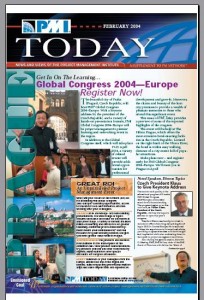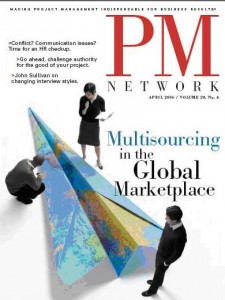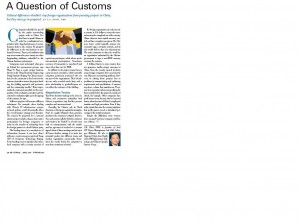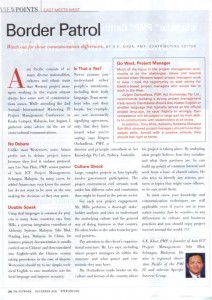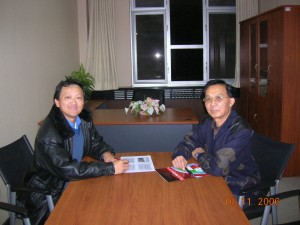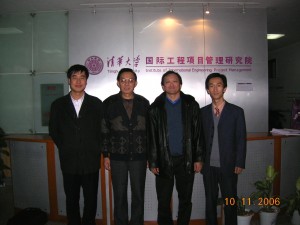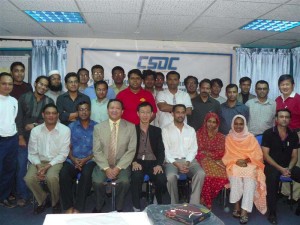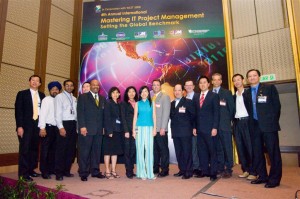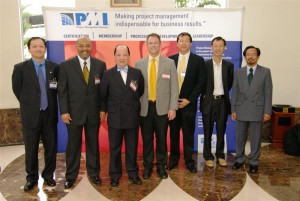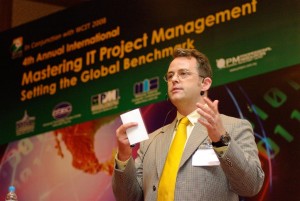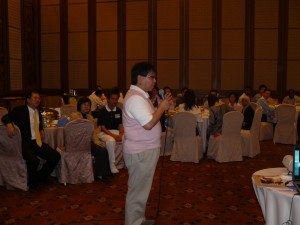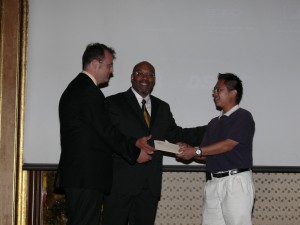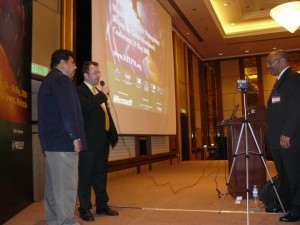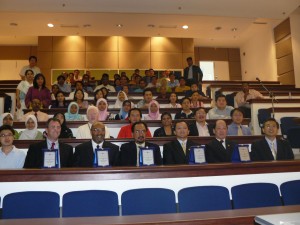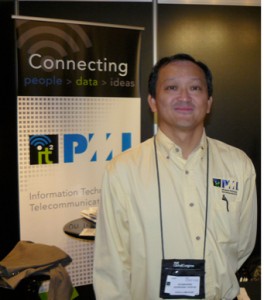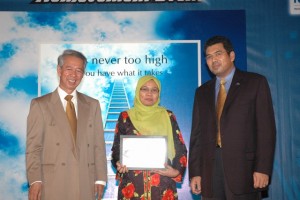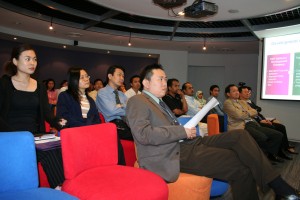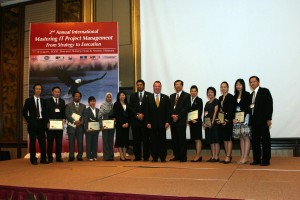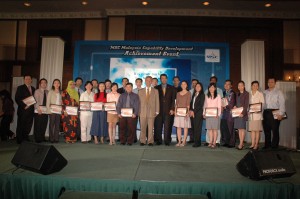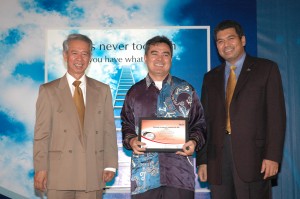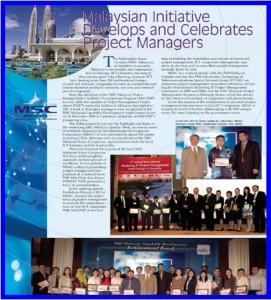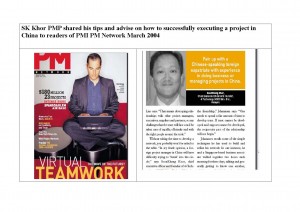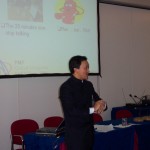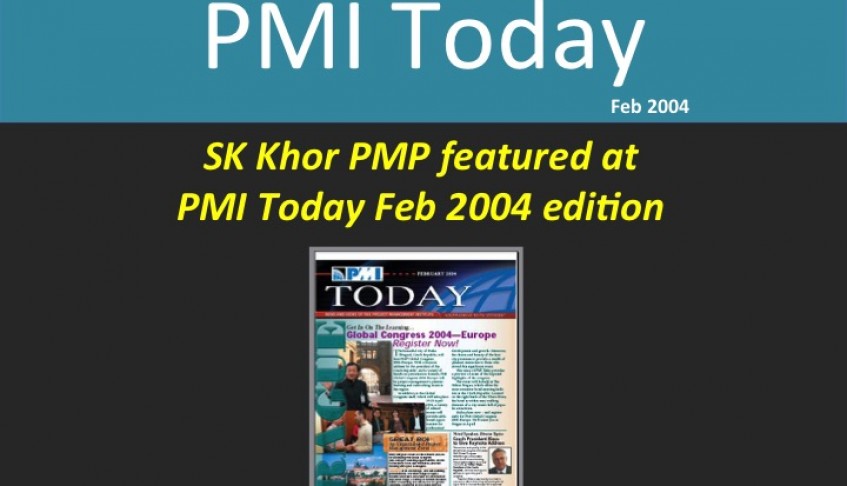
PMBOK

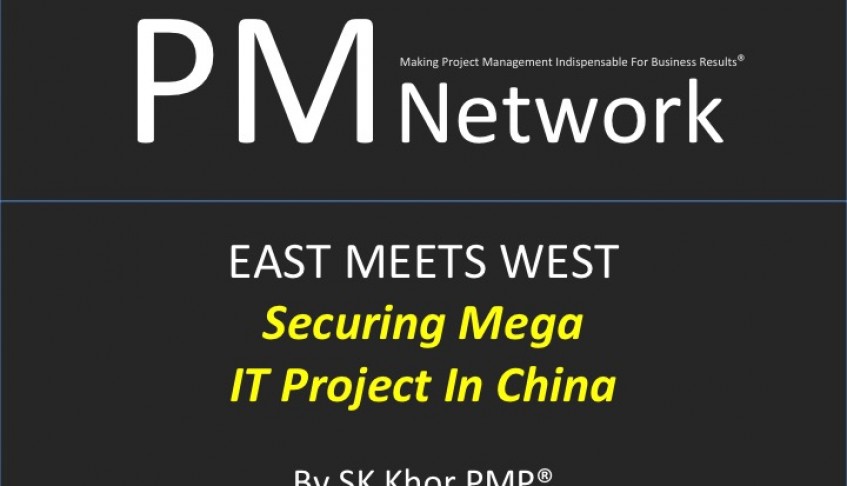
PMI PM Network (Apr 2006) : Securing Mega IT Project in China
SK Khor Publication Malaysia, Management, PMBOK, PMP, Project, SK Khor
Shorter version of this publication was published by SK Khor PMP on PMI PM Network Magazine (April 2006 Edition)
Cultural differences shouldn’t stop foreign organizations from pursuing projects in China, but they must go in prepared. BY S. K. KHOR, PMP
Companies shouldn’t be put off by the myths surrounding project work in China. You don’t have to speak Chinese or work for a multinational corporation with a long local presence to secure business deals in the country. Be prepared for differences in the way business is conducted, however. Terms and conditions that may seem unusual in your country are often longstanding traditions embedded in the Chinese business environment.
Companies must understand what goes on behind the procurement process, says Wang Yi Ping, a senior project business director at the China Electronic EngineeringDesign Institute, Beijing. ……
……………………………..
SECURING Mega IT Projects in China
As the newly promoted Regional Manager in your organization, your first task is to secure by tender, a project which your organization has been pursuing, and to formalize it with a contract. What would your immediate reaction to this first assignment from your CEO who is banking in on this project for the major breakthrough into the massive Information Technology market in the world fastest growing market of China be?
The common and immediate responses from a person facing this scenario are most often that they do not have the ability to speak and understand the Chinese language nor the Chinese’s business practices. However, multi cultural issues should not be a hindrance. The fact that you have to speak Chinese to secure business deals in China is a myth. Nor it is necessary for your organization to be one of those Multi National Corporation with a long local presence in China before you can secure your first IT contract in China.
In China, the difference lies in not treating it as just another tender whereas a norm the justification and logistic for the entire project has been established and confirmed. Understanding what goes on behind the entire procurement process is according to Mr. Wang Yi Ping, a Senior Project Business Director of China Electronic Engineering Design Institute says differentiate a successful tender and a failure. “ In China, it is prudent for the contractor to find out how the customer intend to source for the project funding, the bidding approach and processes, the contracting models and most importantly the contractor has to find out the composition of the evaluation committee and the criteria for evaluation right up to the management of the clarification session until the deal is formalized with the signing of the contract”. Mr. Wang added.
Different type of projects will of course warrant different handling; the range can be as diversified from a private enterprise project such as a Call Center System for a bank to a Mega IT infrastructure system project. In the later, the Chinese National policies may have direct relevance and could affect the overall project strategy and direction. A national mega airport project for example has seen the incorporation of clauses in the Request for Proposal (RFP), which restricts foreign companies’ participation or insists on the transfer of technology from the foreign partner to local Chinese party. It was highlighted by some unofficial sources that the incorporation of these clauses serve to reduce the dependency for the services of the contractors upon completion of the project namely during operation and maintenance phases.
PROJECT FUNDING
The funding source is the most crucial piece of information a potential foreign contractor ought to obtain, as it can have direct influence on the procurement mode, according to Jack Yang, CEO of Groupwise Technology based in Beijing who has recently been awarded a sizeable IT Project for Nanning State Government alongside with a few International European based IT solution provider. Some funding sources have stipulation, which only entails a local Chinese company with a certain amount of paid up capital to participate whilst others put forth a preference for international participation. They are yet some who would stipulate the preference for the currency of transaction which most often than not is in the Chinese currency of RMB.
Project Procurement Processes
There have been many vendors who have been caught in many unexpected situations. Upon purchasing the Request for Proposal (RFP) from a prestigious project owner in Beijing, a group of five prospective companies were requested by the project owner to work together to submit a common IT solution for the project. The project owner only stipulates verbally that one of the five would be awarded the contract to implement the proposed common solution. Three companies opted out as there is no agreement to indicate that their services would be paid. The remaining two companies however proceeded to offer a “pre-contract” free service in the hope that it would develop “Quan Xi” of goodwill and of course the ultimate aim of securing the contract.
Procurement Committee
The Procurement Committee is formed in addition to the project team and this team normally comprises of prominent personnel who is not part of the organisation and whose identity would only be revealed very much later in order to keep their identity from being made known to potential contractors. Even then, the procurement committee decision can be skewed towards the preference of the individual team where factors like price or technology comes into play. A prior relationship or “Quan Xi” can also affect the outcome of the bidding.
Negotiation
Top down decision-making is the common practice in China. It can be deemed as a complex procedure and rather unconventional if the contractors are not familiar with the Chinese negotiation capabilities.
Generally, the Chinese customer are familiar and do utilise the more familiar American or European negotiation skills which to the rest of the business world is an accepted form of practice. However, it is wise not to be caught off guard when “out of the norm” negotiation practice, which is only peculiar to the Chinese, is adopted. It could take effect in the form of a literally “closed door” or in this case “locked door” meeting where both customer and vendor are “locked “ in a hotel room with no communication with the outside until an agreement is reached or a contract signed. It has been recorded that some of these meetings can last up to 48 hours. Another scenario would be then the customer invite two potential vendors into two different rooms and commence negotiations concurrently with or without the vendor knowing that a similar meeting with a competitor is being held next door. Upon the expiry of the 24 or 48-hour time box, the customer would then decide as to whom the contract would be awarded to. Some people said there is nothing unethical as they are merely seeking the best deal. But some, especially those from the West feel strong and against the ‘Reverse-Auction’ negotiation tactic used.
SIGNING FOREIGN CURRENCY BASED CONTRACT
If a foreign organisation can only execute a contract based on the USD currency or the Euros, it is wise to note that the actual transaction can only be executed out of the country as China observed very strict capital currency control and has a very complex tax system. In a situation like this, the Chinese buyer would normally propose to the contractor to sign a tri-party contract whereby the role awarded to the contractor would shift from a prime contractor to that of a sub-contractor. The appointment of a third party who in this case is an organisation who has been authorised by the Chinese Government to sign non RMB currency contract would emerged as the main contractor. It is prudent to be cautious when confronted with a situation like this.
TO VENTURE OR NOT TO VENTURE?
Ultimately, it is important to ensure that you are well armed in your preparation for the way business is conducted in China. The traditional ways of conducting business, the terms and conditions which may seems ‘unusual’ in your country may has long been embedded in the Chinese business environment and cannot be changed instantaneously.
A brilliant history of past performances in your country will not guarantee similar successes in China. Since China opens its doors, there has been much foreign participation in securing projects in China. Some have managed to have profitable closing just as there are many more who are encountering problems in closing their projects or taking the profit out from China
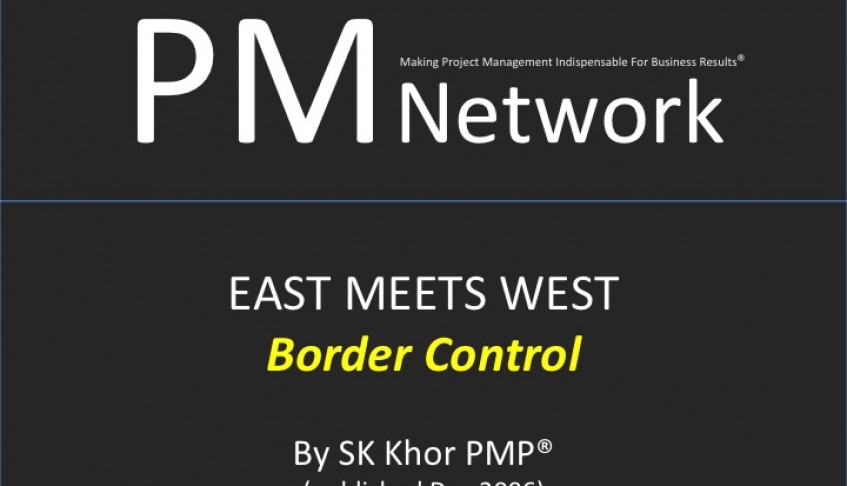
PMI PM Network (Dec 2006): Border Control
SK Khor Publication Malaysia, Management, PMBOK, PMI, PMP, Project
Shorter version was published by SK Khor at PMI Network Magazine Nov 2006.
…………
Background:
The 2nd Annual International Mastering IT Project Management Conference ( www.mitpm.org ) held on 1st ñ 2nd August 2006 in Kuala Lumpur , Malaysia was completed successfully with PMI Chair, Mr. Iain Fraser delivered an high impact keynote on Project Management As Strategic Partner which attracted regional media and Project Management Practitioner in Asia Pacific region. Influential Communication has been choose as Pre-Conference Seminar topic due to its importance during the process from Strategic to Execution.
SK Khor, PMPÆ , Asia Pacific Chair of PMI IT & T Specific Interest Group takes the opportunity to seek views of the some leading Western and Eastern based Project Managers in Asia Pacific region. It is interesting to find out among the 200 plus individuals conference delegates with various views in the importanceís of project communication. Some said it is a reflection of Project Managerís values, beliefs, thoughts, feelings, culture, religion, etc. Some said just to ensure the contents of Project Plan has been communicated to all stakeholders and manage expectation
………..
WEST MEET EAST
Communication Techniques, Issues and Challenges
INTRODUCTION
The 2nd Annual International Mastering IT Project Management Conference ( www.mitpm.org ) held on 1st – 2nd August 2006 in Kuala Lumpur , Malaysia was completed successfully with PMI Chair, Mr. Iain Fraser delivered an high impact keynote on Project Management As Strategic Partner which attracted regional media and Project Management Practitioner in Asia Pacific region. Influential Communication has been choose as Pre-Conference Seminar topic due to its importance during the process from Strategic to Execution.
SK Khor, PMP® , Asia Pacific Chair of PMI IT & T Specific Interest Group takes the opportunity to seek views of the some leading Western and Eastern based Project Managers in Asia Pacific region. It is interesting to find out among the 200 plus individuals conference delegates with various views in the importance’s of project communication. Some said it is a reflection of Project Manager’s values, beliefs, thoughts, feelings, culture, religion, etc. Some said just to ensure the contents of Project Plan has been communicated to all stakeholders and manage expectation.
Decision and conflict resolution
Tony Mills (Tony), a British origin Airport Systems Specialist who has been residing and engaging projects in Asia during the last 16 years has observed that most large projects in Asia are very hierarchically based, even small decisions often have to have the sanction and blessing of Management, decision by committee is often the way the client will move forward, sometimes this lengthens the decision making process. Often the actual decision making is with one or two key figures versus the Western approach is to provide empowerment at the appropriate level and only to escalate when circumstances or the situation requires high level management approval.
Mr. Lee Nan Phin, PMP, senior partner of Asia ICT Project Management based in Malaysia has a different observations. He said, some Asians prefer not like to debate heavily over certain project issues because of the reasons of protocol and “saving face” practises must be observed. Commonly seen also is during the project conflict resolutions, some like to forward the problem upwards for decision in order to respect the protocol or some just refused to confront their peer in order to maintain good ‘Guan Xi’. On the other hand, Westerners in his project will confront and debate the project disagreement but will make decisions at the designated level. Even more interestingly, in many cases, an Asians may know the answer but do not want to be seen as the one making the decision. Mr.Lee added.
Language and Body Language
Tony has also observed the usage of dual language is common for projects in many Asian countries. In China for instances primary documentation is in Chinese and then translated into English. The rule is that the Chinese version takes precedence in the case of dispute. Therefore it is extremely important when a non Chinese vendor is involved that the translated documentation reflects as precisely as possible the meaning of the local language; Westerner should try to use Simple Technical English to ease the translation into the local language and improve accuracy.
Juergen Oschadleus,PMP ,South African origin based in Australia has learned that people nodding their heads, a characteristic often attributed in Eastern culture does not necessarily signify agreement, only that they have heard. E.g when a foreign contracted workers kept saying ‘YES’ while shaking his head violently from side to side when asked by the local technical lead he has understood the project requirement. The challenge here is never to assume we understand other people’s intentions, including their body language.
Culture and Business Practises
Large complex projects in Asia typically involved government participation. It is important for you to envision the project environment that the civil servants may work under different rules and constraints as compared to the project team members from private sector.
For each new project engagement, Mr Lee will perform stakeholder analysis thoroughly and understand the project environment well from several aspects such as underlying culture, general way of doing business in that country. He often obtained help from the Sales team to get initial general pointers. Mr. Lee will also seek to understand the Client’s Organisational structure and where the clients Project Manger positions sits within the structure and what power and constraints that they may have.
Jurgen will go further to read books on culture and history before entering to the country where the project will take place. In particular, what do the people believe, how do they socialise, and what sport or other past times do they participate in. Jurgen believes this can help to build up points of common interest and allows him to work from a base of shared values. He will also try to identify any specific actions, gestures or topics that might cause offence, and then avoid those as far as possible.
Survival Tips
As Western Project Manager, Tony doesn’t feel he needs to do anything significantly different when he needs to communicate with either a Westerner or Easter based team member. However, he will always try to apply the below five Critical Success Factors which equally importance to his projects.
- Attitude: He will portray the right attitude, neither arrogance nor subservience. Flexibility is an important card to be played at appropriate times
- Discipline & Work Ethics: He will impose discipline and to be a role model for his own team.
- Listen: He will really listen and do not be formulating the next argument in his head until he has heard the client’s representative out. He will avoid the common mistake of his Western co-worker who think they know better so they are not really listening.
- Communicate : He is constantly improving his written and oral communication skills in order to communicate clearly and succinctly and often trying to use simple and plain English.
- Patience: He will approach the project with Patience. Many things will appear initially not to go the desired way because the client needs time to appreciate the Western PM recommended way, even to the point of doing it wrong their way first.
Crossing Ocean
We have seen many white papers, research and presentation in the PMI community attempts to address challenges, issues and lesson learnt faced by Western based PM in Asia. I decided to do the reverse. I took the opportunity to seek advices from the Western based PM on tips for an Eastern based Project Manager to earn himself the opportunity to manage a project of his field of expertise in the West.
Jurgen believes a strong Project Management credibility and track records will be the top of the evaluation list in his countries such as South Africa and Australia. He also advise them to master the official project language such as English, because, rightly or wrongly, their competence will be judged in large part by their ability to communicate at all levels of the project stakeholders and is critical for success.
Once in the country, it is also important to integrate into the society; by all means, maintain your own traditions and culture at home, but don’t isolate yourself from your new community. And, of course, network widely. Most of the job opportunities are not advertised, they are referred, so use every opportunity to build up a network of contacts in the country you plan to move to, and let the network know of your interest, skills and availability. Jurgen added.
In additional to above, Tony stressed all Project Manager must have a combination of the soft skills such as Patience, Listening, Discipline, Communication and above all Right Attitude in order to earn himself/herself the passport to manage projects outside his/her home grown country.
SUMMARY:
All projects will face some sort of Communication Issues and Challenges regardless of its geographical location, mother-tongue or cultural background of Project Manager. In most cases, your knowledge and commonly practised communication techniques used elsewhere can still applicable with some additional listening effort if your project is operated in multi-languages environment and be extra sensitive if you are new to certain underlying culture and business practises.
In conclusion, It is very difficult to give finite precise answers on how to avoid communication issues and challenges within Asia as it consists of so many diverse nationalities, cultures and ethnic traits. The political, social and religious environments are also many and varied. As someone ‘Being There, Done It’, what I commonly practises included to meet with the group collectively and the team members individually, in order to get to know them as people. Identify the dynamics between them early on.
At the end of the day, effective and influential project communication is about relating to people; that requires getting to know them, respect them and care about them as truly unique individuals. Once I have a clear grasp of the local “Rules of Engagement’ I will have to establish better understanding and trust with my counterpart and hopefully this will ease majority of the communications barriers between the parties considerably. Good luck to your next Project in Asia.
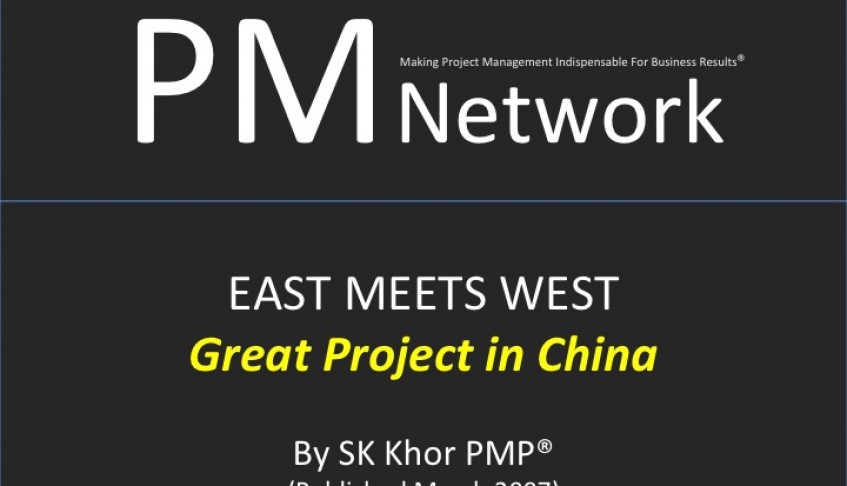
PMI PM Network (March 2007): Great Projects in China
SK Khor Publication China, Malaysia, Management, PMBOK, PMI, PMP, Project
An ancient project legacy continues with modern practices.
Spurred by a growing economy, China is rapidly adopting Western technology and terminology to advance project management capabilities-hut with its own local twist. I discussed the past, present and future of project management in China with Wu Zhiming, construction management professor at Tsinghua University, Beijing, China, at the September 2006 International Project Management Forum in Hong Kong.
How did the concept of project management apply in ancient China?
Mr. Wu: Although the term project management was coined in the West, the concept has been present since ancient China. For most, the Great Wall will remain the iconic project in the history of China, but there are many other noteworthy projects where project management methodologies were already being used. …
{ The shorter version of the interview was published by SK Khor for PMI PM Network Magazine March 2007 Edition}
…………….
The Past, Present and Future of Project Management in China
Following is an exclusive interview by PMI PM Network Contributing Editor for the Asia Pacific region, Mr. SK Khor, PMP® with the keynote, Professor Wu Zhiming, Tsinghua University, Beijing, China during the recent International Project Management Forum in Hong Kong.
Professor Wu is also Director of Beijing Project Management Institute and member of PMI USA. He has more than 40 years of experience of teaching, research and consulting on construction and project management in China and overseas. In 2000, he received the Award of Outstanding Scholar in 20th Century from the International Biographic Center ( IBC) of Cambridge, United Kingdom.
Professor Wu , shares with Mr. SK his thoughts on The Past, Present and Future of Project Management Practise in China.
Mr SK: How did the concept of Project Management apply in ancient China ?
Prof Wu: Although the term “Project Management” is coined by the Western world, the concept of Project Management has been functional since ancient China
Most people will view the Great Wall as one of the icon projects in the history of China but there are many others. One outstanding success story is the Bian Liang Palace Re-construction Project.
During the Song Dynasty, the Emperor appointed his minister Mr. Ding Wei to re-construct the palace at Bian Liang City. The minister established a comprehensive project implementation plan As he realised the project required a lot of soil, the minister instructed his men to burrow soil from the main road within the vicinity of the palace. After all the soil was dug out a big drainage was formed and he instructed his team to connect the drainage to the main river nearby. This formed a cannel which became a perfect water transportation system to transport materials in and out from the project side which further helped reduce project cost and time.
After the re-construction of the palace, the project team placed all the construction waste into the cannel, levelled it up and returned the main road to its original condition.
Mr Ting’s effective project approach solved major logistic problems by converting project risks into opportunities led to a major overall cost
saving.
Mr SK: What was unique about those projects undertaken during ancient China ?
Prof Wu: Most of these projects were mega construction projects initiated by the Emperor with “unprecedented” project priority. A lot of effort were put into planning and execution to ensure project success.
Mr SK: When and how was the Western Project Management concept introduced in China ? How do you view the influence of Western Project Management Practices in China today?
Prof Wu: In the late 1950’s, the Critical Path Method (CPM) and Program Evaluation and Review Techniques were introduced to China by a well-known Chinese mathematician, Professor Hua Loh Geng.
Professor Hua had taken the initiative to promote these concepts to the working class, and his efforts have since greatly encouraged the adoption of modern project management techniques in the country.
Chinese Project Management practitioners term this method as “Network Planning Technique” and it has become the most commonly used technique in China’s Project Management. Modern Project Management first being introduced to China by the World Bank financed project during the period of 1980s to 1990.
Our project histories, experiences, and lessons learned has become valueable organization assets and form part of our heritage. Our mission is to continue the tradition, as well as adopt and adapt Western technology to further develop our own project management capability.
We need to overcome challenges such as language and terminology. Also we need to realign our focus areas. For example, contractors in China are particularly interested in the areas of procurement and contract administration.
Mr SK: Can you describe the latest developments in Project Management in China?
Prof Wu: In the early 1990, the Project Management Institute (PMI) and Institute Project Management Association (IPMA) began its venture into the China market. The early version of C-PMBOK ( Chinese Project Management Body of Knowledge Guide ) was published as a result of the First International Project Management Conference in Beijing in 2002. In 2003, Great China Project Management Advanced Committee (GPAC) was established in Hong Kong.
Mr SK: Can you give some examples of mega projects completed in the last 20 years in China?
Prof Wu: I will start with the “Lu Bu Ge Project” –a World bank funded Hydro-electric Dam Project – undertaken in the 1980’s. The project construction side is located at the border between Yunnan and Guizhou Province.
Upon completion, the dam was to generate 4x150MW electricity. The tunnel project contract was opened for international bidding. Modern Project Management was introduced and it helped to improve quality, shorten the project duration and maximise the return of investment. The project became a distinctive success story in the industry and got the attention of the former Chinese Premier , Mr. Li Peng.
The
Lu Bu Ge Project has introduced three important elements into China’s project management:
- Owner Responsibility System;
- Construction Supervisory System; and
- Contractor Bidding System
Other successful mega projects in China include the Three Gorges Dam, Qing Zang Plateau Raiway and Shenzhou-6 spaceship program.
Mr SK: Aside from the success stories, which projects would you consider as challenging?
Prof Wu: Sure. I think the ‘Er Tan Hydro-Electricity Project” is one project that best fits into this category. The project has become an academic case study for “project successfully completed but failed to achieve its intended objective”.
The project site is located at Sichuan Province at YaLong river. Upon completion, the dam was expected to deliver 6x 550MW of electricity. Total project investment was 28.5 billion Ren Min Bi (RMB). Of this amount, USD$930 million were loans from the World Bank and other sources.
The contract was also opened to international bidding. The project was completed in 1999, ahead of original schedule, within budget, and was of excellent quality.
The aim of the Project was to overcome the major power shortage in the Sichuan Province. However, during the construction period, two events took place which affected the project – new coal power plants were built which provided additional power supply of 158mega watts; and the city of ChongZhing is separated from the Sichuan Province and municipality directly under the Central Government.
Upon completion of the hydro-electricity project the city of ChongZhing declined to exploit this power supply and this created a situation where Sichuan had excessive power supply, wasted a lot of water and resources.
After many years of continuous effort from the Government and the project management team, this problem has been resolved.
Mr SK : How important are Project Management related certifications in your country?
Prof Wu: China is a very competitive market. People like to have additional certifications in order to stand out in the highly competitive job market. It might come as a surprise for some to hear that there are currently five different certifications in China:
- Project Manager Title from Ministry of Labor and Social Security
- Registered Construction Professional from Ministry of Construction
- Project Manager from Ministry of Construction
- IT Consultant and Manager from Ministry of Information Industry
- Registered Consulting Engineer from Development & Reform Committee and Chinese Association of Consulting Engineer
Mr SK: Earlier you briefly mentioned about C-PMBOK®. Can you tell us more about this guide?
Prof WU: C-PMBOK® is part of the project management nationalization and standardization efforts.
C-PMBOK incorporates the strengths of various International Project Management Literatures such as PMI’s PMBOK® with consideration of the Chinese specific business and project conditions. The contents consist of Project Life Cycle, Project Management Knowledge Areas and Tools and Techniques to implement project in China. However, it has strengthen the contents for Conceptualisation phase and Transition phases from Development to Operation.
Mr SK : In your opinion what are the major challenges faced by Project Management practitioners in China?
Prof Wu: China is a growing market.and project management is developing accordingly. Three different versions of C-PMBOK have been introduced by three different organizations within four years, and five different Project Management related Certifications have emerged during the last six years. The growth is definitely encouraging and it shows that Project Management is being positively adopted in this booming economy.
On the same note, I would like to stress that PMI and IPMA has tremendous growth opportunities in China. China’s current booming market allows different players to find their niche areas and engage in their strengths.
However, project managers need to ask themselves whether this diversities help to promote Project Management practices or are stopping blocks ? And what they can do about it.
Mr SK: What are China’s Project Management standardization and localization efforts and what is your wish list?
Prof Wu: As far as standardization and localization are concerned, we have to integrate the local situations with the new elements imported from the West. We need to continue to innovate and improve. However, we cannot blindly follow what others are doing if it conflicts with local
state of affairs.
I hope to see Project Management moulding Chinese various industries to innovate, transforming “Made in China” to “Created In China”.
In order to achieve this, we must first understand the uniqueness of managing projects in the Chinese environment.
For example, we need to know
the maturity of legal system for intellectual property and contracting, the element of ‘Quan Xi’ and ‘Drinking Culture’ in business and day-to-day life. To a certain extent all these contributes to project success.
We also need to update ourselves on the global trends of Project Management development. These includes areas such as how to further improve a Project Manager’s people skills , innovative ways to deliver Project Management education and training to all levels of stakeholders and buy-in from the senior management at Government and Chief Executive Officer (CEO)levels.
I also hope to see more constructive discussions taking place on the challenges and issues faced by current Project Managers in China and positive feedbacks on the Process of Standardisation and Localisation of Project Management in China via Internet, seminars and media publication platforms.
The Project Management community in the Greater China and South East Asia should hold more dialogs, meetings, discussions, seminars and conferences to further promote the collaboration and the integration of the profession.
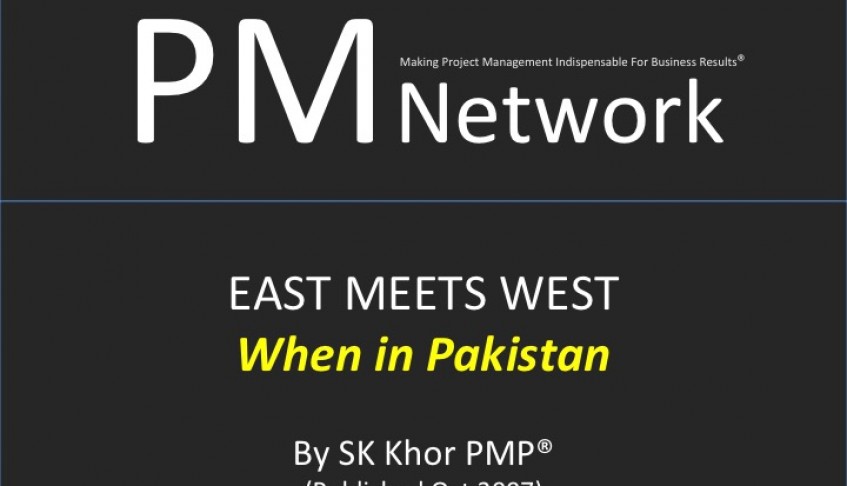
PMI PM Network (Oct 2007): When in Pakistan
SK Khor Publication Malaysia, Management, Pakistan, PMBOK, PMP, Project
[vc_row][vc_column width=”1/1″][vc_column_text]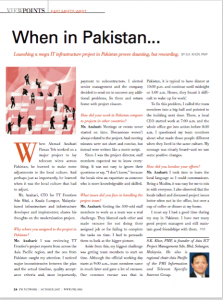
Shorter version of this paper will be published in the 2007 Edition of PMI’s PM Network monthly Magazine.
Getting the mega IT Infrastructure done on-time in Pakistan : Issues and Challenges
In an exclusive interview, PMI PM Network Contributing Editor for the Asia Pacific region, Mr. SK Khor, PMP® speaks to Mr. Ahmad Azahari Pawan Teh an experienced project manager, who just recently completed a mega telecommunication infrastructure project in Pakistan.
Azahari talks about the unique challenges , issues and techniques he used in leading and managing a team of more than 300 people to complete one of the major modernisation efforts in Pakistan.
The project scope was to lay the telecommunications cables across Pakistan which can subsequently be rented, leased or sold to different telecom service providers to provide voice , data , internet or multimedia services. The project team was scattered across the country as far as 4,500 km apart.
Azahari has more than 20 years of experience in leading and managing Information Technology and telecommunication projects across the Asia Pacific region. He used to as head of technical division for an international telecommunications player based in Malaysia and currently as Chief Technology Officer for TT Frontiers Sdn Bhd in Malaysia.
Mr SK: Why where you assigned to the project in Pakistan ?
Azahari: One afternoon, as usual I was reviewing various project reports from across the Asia Pacific Region and the Monthly Project Report from Pakistan caught my attention. I noticed major inconsistencies between the job of completion, timeline, quality acceptance criteria and most importantly payment to sub-contractors.
I alerted senior management and advised them to send someone from headquarters to Pakistan to better understand the actual situation. The senior management decided to send me to Pakistan to uncover more problems, fix them and return home with perfect project closure. This eventually led to me becoming the Chief Technology Officer for six months for this multimillion dollar project !!
Mr. SK : What was different about your encounters here compared to projects outside of Pakistan ?
Azahari : I made some interesting observations in the first week. Meetings or events never started on time, a lot of discussions took place on project or non-project related issues and the project meeting minutes were not short and concise but was written in the movie script format.
My first month was filled with challenging questions from my direct and indirect reporting staff. Since I was the Project Director, they also expected me to know everything. I felt that the local team leaders were conducting informal assessments on my technical expertise.
It was not easy to ignore their questions or say ‘I don’t know’ because the locals view an expatriate as someone who is more knowledgeable and skilful since he comes from a more “advanced country”. Otherwise an expatriate who enjoys a lot of benefits is considered a wasteful ‘import’.
My years of experience in projects in the IT and telecommunications industry helped me to handle this situation.
Mr SK : What were the challenges faced in handling this project team?
Getting the 300 odd staff to work as a team was a real challenge. I had four General Managers directly reporting to me. More than 20 Project Managers reported to these four General Mangers and each Project Managers were responsible for 10 to 20 project team members.
They blamed each other and made excuses for not doing the job assigned or when failing to complete the tasks on time.
Being the boss, I was just as responsible for any delay or incompletion of tasks. Hence, I decided to put a stop to this behaviour.
I had to spend time and effort to persuade them to look at the bigger picture, to view the situation from the entire project and/or from the company perspective and not at personal or sub-project level. I did manage to impart some team work concept but it was not an easy task.
Aside from this, my biggest challenge was getting my entire project team to start their day on time. Although the official working hour starts at 9.00am, team members came in much later. A lot of excuses were given for coming in late to work. One commonly heard excuse was that it is the Pakistani culture to have dinner at 10.00pm and continue until midnight or 1 am in the morning. Hence, they sleep late and find it difficult to wake up early for work!!
To fix this punctuality problem, the management tried some frequently used Western techniques but nothing really worked. We even made a decision to impose salary cut for late comers but this also did not make any significant change.
Then one day I called the entire project team members into a big hall which had direct view of the next building. I pointed them to this office building which had a local Chief Executive Officer who started work at 7.00am and the whole office got into action before 8.30am.
I questioned my team members about what made them different when in fact they live in the same culture and environment as the people in the building next door.
My message was clearly heard and understood by a majority of the team members and we saw some positive changes.
Mr. SK : How different was it in managing contractors and sub-contractors?
Azahari: Same as else where, our contractors and sub-contractors will find ways to get paid faster without completing the work as agreed upon. They would try to lie about project status and present misleading information in the project reports.
Some of my project managers without much hands-on experience couldn’t put their fingers on the false reports. It was also not easy for them to prove the actual situation and it was not practical to request the contractors to show the actual work done as it will involve project resources and time.
I then introduced the Independent Project Quality and Audit team from third party organisations and also management surprise visit. We established standardised quality and audit processes and communicated with contractors that the project quality reports and audit reports will contribute to the decision on their claims or payment.
This move did help to put a stop to poor quality of work.
Mr SK: What were your localization efforts ?
Azahari : I am always sensitive whenever in a different country. The same applied when I was in Pakistan. I took time to learn the local language to be able to communicate with the locals. Being a Muslim, it was easy for me to mix around with everyone in the predominantly Muslim country.
That aside, I also observed that the locals talked/discussed about project issues better when not in the office but over a cup of coffee or dinner at my home. I must say I have a good time during my stay in Pakistan and I have met many good Project Managers and still maintain good friendship with them.
[/vc_column_text][/vc_column][/vc_row]
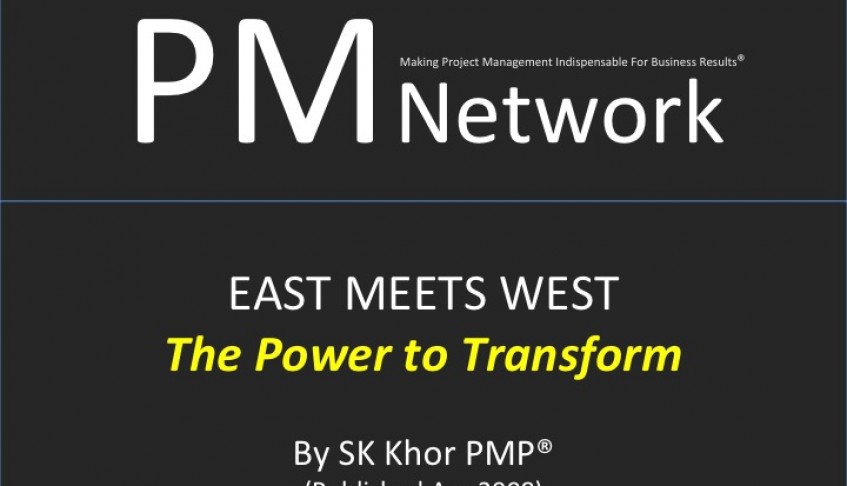
PMI PM Network (Apr 2008) : The Power to Transform
SK Khor Publication Bangladesh, Malaysia, Management, PMBOK, PMP, Project, SK Khor
Project management is helping Bangladesh change its future.
by S.K. Khor, PMP
Though right next door to the emerging economic force of India, Bangladesh remains one of the poorest countries in the world. But some residents are looking to project management to help take the country to the next level. On recent visit to Dhaka, the country’s capital, I have noticed that Project management in Bangladesh is quite unique, as most projects are largely dependent on the availability of financing. The completion date is secondary and could be deferred based on the availability of funds. The environment has indirectly affected the thinking of many managers handling projects and some of them believe it is all right to shift target dates and derail the entire schedule.
And the perception of the project manager role in Bangladesh is often different than what’s found in more established markets.
“When I worked as a project manager outside of Bangladesh, I had to assume all responsibilities for project activities and was accountable on the success or failure of the project,” says Razif Yahya, PMP, Assistant General Manager at mobile communications company Aktel.
But in Bangladesh, “many of the critical decisions are left to higher management or, in some cases, the project sponsors,” he explains. “It may be a few weeks, if not months, before they respond, but this duration is typically not factored in any project schedule or cannot be factored in due to political reasons. This, in a way, has created a ‘flexible dateline’ culture, which is against A Guide to the Project Management Body of Knowledge (PMBOK® Guide).”
Project managers also have to oversee operational matters, Mr. Yahya says, which leads to “confusion of roles and responsibilities” and adds to the schedule overruns.
Force of Nature
Along with all the other scheduling risks, project managers in Bangladesh must contend with civil unrest, curfews and environmental disasters, Mr. Yahya adds.
“It will rain continuously for three months usually in June to August,” he says. “In planning long-duration projects, this has to be taken into account as risk. Following that, we have to prepare for the event of cyclone attacks or flood. This will definitely impact the project scope, cost and time.”
It’s not uncommon for these factors to delay a pilot project, which is then relaunched—stuck in “forever pilot” mode, he says.
Mr. Yahya says it’s important to have trained professionals whose judgments stakeholders or sponsors will trust. Once that faith is gained, project managers will be empowered.
——–
[bio] S.K. Khor, PMP, is founder of Asia ICT Project Management Sdn. Bhd, Selangor, Malaysia. He also is regional chair—Asia Pacific of the PMI Information Technology and Telecom Specific Interest Group.
——–
Shorter version of this paper will be published in the 2008 Edition of PMI’s PM Network monthly Magazine.
Project Management Landscape in Bangladesh – Issues, Challenges and Opportunities
Key words : Bangladesh, highly populated , high illiteracy rate , devastating natural disasters , political instability, Flexible Dateline, Forever Pilot, High Impact paradigm shift project management Effort , Formation of PMI Bangladesh Chapter
After I penned down an article about Project Management challenges in Pakistan, PMI PM Network Contributing Editor for the Asia Pacific region, Mr. SK Khor, PMP® had given a few opportunities to deliver project management training and seminars in the neighboring country, i.e. Bangladesh.
Bangladesh: home to around 140 million people, with rampant — but decreasing — illiteracy rate, and rapid development. Despite being prone to devastating natural disasters, the most recent being the Cyclone Sidr in November 2007, and regular intervals of political instability with outbreaks of manifestations and public protests in the streets, this third-world country is certainly well-known for its exported workers.
The opportunity to collaborate with various groups of people in Bangladesh who were committed on improving the way projects have been initiated, planned, and managed presented itself to Mr. SK when he came to Dhaka, Bangladesh, for a short visit. Among these personnel include USA-trained Bangladeshi and expatriates such as Mr. Mikail Islam, Acting Executive Director from Chittagong Skills Development Centre (CSDC, www.csdc.com.bd) which is the first industry-led, non-profit skills training centre in Bangladesh. Ms Jenny Yang, representative from GSM Association (www.gsmworld.com) , Mr. Razif Yahya, PMP®, Assistance General Manager from Telekom Malaysia’s subsidiary Aktel and also Chairman of ICT Working Group for CSDC.
SK: Can you tell me the general understanding on the term of Project Management in Bangladesh?
Mr. Mikail from CSDC: In my observation, in general the project management in Bangladesh is quite unique as most projects are largely dependent on the availability of financing and completion date is secondary and could be deferred based on the availability of funds. It could be seen that some large scale constructions stopped in the middle of the projects due to budget constrain are rampant.
This environment has indirectly affected the thinking of many managers handling projects that it is alright to shift target dates and derailed the entire schedule. No accountability on the impact of delays and the final cost of the project. Hence this became a trend on its own.
In the Universities, Project Management is thought as a subject only. The emphasis on post graduate program on Project Management and PMP is very new in Bangladesh.
SK: What is the perception of a Project Manager role in Bangladesh? How is this different or similar to what we usually seen outside of Bangladesh?
Mr. Razif, a certified PMP from Malaysia: When I worked as a Project Manager outside of Bangladesh, I have to assume all responsibilities project activities and accountable on the success or failure of the project. In Bangladesh, many of the critical decisions are left to Higher Management or in some cases the project sponsors. It maybe a few weeks if not months but this duration is typically not factored in any project schedule or can not be factored in due to political reason. This in a way has created a ‘flexible dateline’ culture which is against the PMBoK. In additional to this, the managers handling the project will also have to oversees operational matters which lead to confusion of roles and responsibilities and hence caused project schedule overrun.
It is important to have trained professionals whom Stakeholders or Sponsors have confidence in their judgments. With this, proper empowerment could be made to this Project Managers as it is important for successful delivery of projects based on its scope, cost and schedule. It is different in most developed countries and the west where Project Management is entrusted to professionals whose track records or credentials are benchmarked to internationally recognized bodies.
SK: What was different about your encounters here compared to projects outside of Bangladesh?
Mr Razif: In my personal experience, in most other encounters, the environment is quite controlled as schedule risks could arise from Government interference or civil unrest (in Guinea and Ghana) or curfews (in Sri Lanka) however in Bangladesh it has civil unrest, curfews and also environmental disasters. It will rain continuously for 3 months usually in June to August. In planning long duration projects this has to be taken into account as risk. Following that we have to prepare in the event of Cyclone attacks or flood. This will definitely impact the project scope, cost and time.
A Pilot Project which can not be completed on time due to above reasons is not uncommon to re-launched which lead me to coin a term called ‘Forever Pilot’.
SK: What were the project team related challenges and how did you resolve them?
Mr Razif: I had a young team mostly between age group 20 to 30 yrs old. Although dynamic and vibrant being young, they needed a lot of coaching and guidance in Project Management. Through mutual respect and a lot of patience from both sides, finally we managed to be at performing stage quite early in the execution phase which lead to significant productivity improvement and shorten the time-to-market.
The other challenge was inaccurate reporting and accountability issues. We managed to overcome this by having a Project Management Office whose major part of the Key Performance Indicator (KPI) is to keep tab of project progress and network performance. All information was presented for discussion validated before report in the weekly internal project meeting attended by all project managers. Issues were debated and rationalized in that meeting and major changes or new direction were decided in this meeting as well.
SK: What does having a PMP Title after your name means to the job market in Bangladesh?
Mr Razif: I am so proud with this prestige title as it definitely help me to perform my job more effectively. It reminded me of the rigorous study which I have made to earn the certification and also to be a member of PMI, an esteemed organization regarded highly internationally. It also reminds me of the ethics and professionalism that this title came with. I am proud of my personal decision to embark into the journey as a Certified Project Manager and I definitely encourage more Bangladeshi to do so.
SK: What were your efforts in promoting Project Management?
Ms Jenny Yang and Mr. Mikail Islam: GSM Association and Chittagong Skills Development Centre (CSDC) worked hand-in-hand to promote Project Management through organizing Project Management classes and awareness talk. So far three classes have been conducted and benefited 55 managers in 2007. According to Ms. Jenny Yang , representative from GSM Association which is a global trade association representing over 700 GSM mobile phone operators across 218 countries of the world.
We had our First locally made PMP® on the 18th Dec 07 last year.
I am grateful to have a few dedicated volunteers who share the same love and affection on this subject and had organized a few free seminars to professionals and executives to promote Project Management. We initiated registrations of new PMI members so as to have enough quorums to start the PMI Bangladesh Chapter! On 6 Jan 2008, we had 23 PMI Members already and I am confident we will have more than 30 by end of Jan 2008. I am very happy to see their enthusiasm in propagating professionalism in Project Management.
SK: What is in your wish list to see Project Management practices in Bangladesh, short term (6 to 12 months), mid tem (1-2 years) and long term (2 years or above)?
The three individuals I interviewed share their same vision and mission.
We wish to see Project Management practices to:
(6 to 12 months).. to continue to roll and attract more interest not only in Telco but to other industries eg. Construction and Pipe and Gas etc and we are working hard to have the our 1st convention in Project Management in the history of Bangladesh this year 2008.
(1-2 years).. to successfully instill professionalism in project management and positively affect the professionals and the society.
(2 years and above).. to have better coverage and have PMI Chapters in Regions: Chittagong, Khulna, Sylhet and Rajshahi.
PMI in any Chapter is made up of like minded people. The measure of success of formation PMI Bangladesh Chapter and to sustain it far into the future is gauged by the number of lives we affect positively through instill professionalism in the workplace.
We know this is only the beginning and there are many more steps to go. As for now, I am liaising closely with Mr SK Khor, PMP®, Chairperson for Asia Pacific Region, PMI IT and Telecom Specific Interest Group and Contributing Editor of PMI PM Network for any assistance or guidance for the establishment of this chapter and for promoting activity in Bangladesh.
However, we need help and welcome suggestion, input and visits/ volunteers within and outside of Bangladesh to bring in value of PM in all areas (Telco, military, economics, social economics, financial etc.) to transform one of the poorest countries in the world to the next level. So, please help us to spread the words, let us CONNECT Bangladesh to the rest of worlds through Project Management!
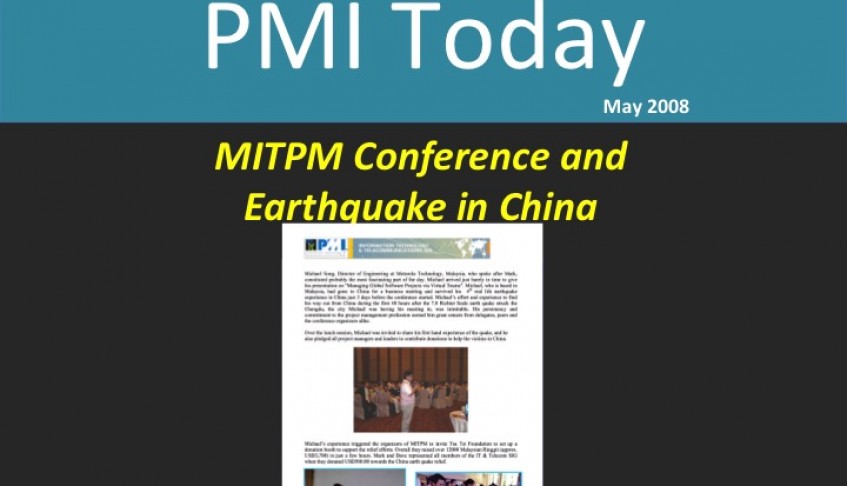
PMI Today (May 2008): MITPM & Earthquake in China
SK Khor Publication Malaysia, Management, MITPM, PMBOK, PMI, PMP, Project
Shorter version of this publication was published at
PMI Today magazine May 2008 edition
19 June 2008 – PMI IT & Telecom SIG Asia Pacific Half Yearly Report
Reported by SK Khor PMP®, Regional Director, Asia Pacific, PMI IT & Telecom SIG
——–
PMI IT & Telecom SIG strengthened their presence in Asia Pacific and contributed to the success of the largest ICT focused Project Management event in the Asia Pacific region.
Mastering IT Project Management (MITPM) is an annual international event for Asian based Project Managers and leaders in the Information Technologies and Communications sectors. In conjunction with World IT Congress 2008 (WCIT), the yearly event, that the PMI IT & Telecom SIG has been proudly supporting since it was kicked off in 2005, was brought forward this year to 14-16 May from the usual 1-2 August timeslot.
The event was themed “Setting the Global Standard”, and successfully attracted more than 530 delegates from various parts of the Asia Pacific region, from Kuwait, Saudi Arabia, Nepal, Taiwan, Hong Kong, Singapore, Indonesia etc., who gathered in KL to learn, network, and share the latest technologies and project management developments in the IT and telecommunications industries.
The pre-conference seminar conducted by Professor Hubert Vaughan from Tsinghua University, China, aimed to assist IT project managers to understand a new way to do proper project scoping from often unclear, or even non-existent requirements in today’s ever changing IT project environments. A post-conference seminar was conducted by Dr. Davidson Frame, Dean of University of Management & Technology in Virginia, USA and a PMI Fellow, with a focus on the use of Earned Value Management in ICT projects.
The main conference keynote “Re-thinking the PMBOK, CMM and ISO 9000”, was delivered by the world renowned Dr Davidson Frame. His presentation showcased how different approaches to project management can be used and blended within the context of the PMBOK, CMM and ISO. In his talk he explored ways where waterfall, iterative and agile practices can each be specifically applied to successfully manage different types of projects, and how these methodologies can be blended together. He was a very energizing speaker and set the tone for a highly informative day, that would cover a number of important topics for IT Project Managers.
Past-Chairman Mr Mark Lurch and current Chair Mr Dave Prior of the PMI IT & Telecom SIG, were invited to share their expertise and experiences during the MITPM Conference. Mr. Dave Prior introduced Agile Methodology to the delegates and shared practical tips on how to implement and use Agile as a project management tool. Mr. Mark Lurch gave a lively presentation on the importance of “Managing IT Projects Like a Business”. As expected, both talks were very informative and delivered with a great sense of humour, and were very well received by the Asian crowd.
Michael Song, Director of Engineering at Motorola Technology, Malaysia, who spoke after Mark, constituted probably the most fascinating part of the day. Michael arrived just barely in time to give his presentation on “Managing Global Software Projects via Virtual Teams”. Michael, who is based in Malaysia, had gone to China for a business meeting and survived his 4th real life earthquake experience in China just 3 days before the conference started. Michael’s effort and experience to find his way out from China during the first 48 hours after the 7.8 Richter Scale earth quake struck the Chengdu, the city Michael was having his meeting in, was inimitable. His persistency and commitment to the project management profession earned him great esteem from delegates, peers and the conference organizers alike.
Over the lunch session, Michael was invited to share his first hand experience of the quake, and he also pledged all project managers and leaders to contribute donations to help the victims in China.
Michael’s experience triggered the organizers of MITPM to invite Tsu Tzi Foundation to set up a donation booth to support the relief efforts. Overall they raised over 12000 Malaysian Ringgit (approx. USD3,700) in just a few hours. Mark and Dave represented all members of the IT & Telecom SIG when they donated USD500.00 towards the China earth quake relief.
Dave and Mark also took an opportunity to conduct a video podcast interview with one of the delegates, who had traveled all the way from Nepal to attend MITPM and to meet representatives of PMI IT & Telecom SIG.
The day ended with a presentation by Professor Vaughan who gave a talk on PMI’s Program Management Standard and its value to an IT Organization as well as a series of lucky draws where Mark and Dave were invited to pick the lucky winners.
In addition to the MITPM event, Mark Lurch, Dave Prior and I had the opportunity to speak to graduate students, lecturers and IT professionals at an event organized by Multimedia University in KL.
Last but not least, the success of the PMI IT& Telecom SIG’s presence during the MITPM would not have been possible without the excellent efforts of the organization committee, which consisted of the Multimedia Development Corporation (www.mdec.omc.my) , Advanced Technology Studies Center (www.atsc.org), Project Management Institute, PMI’s Malaysia Chapter (www.pmimy.org) , and the Malaysian National Computer Confederation (www.mncc.org.my)
This annual event is most definitely a platform for the PMI IT & Telecom SIG to further develop and cultivate our strong presence in the Asia Pacific region. We are proud to be able to share and network with project managers from the Information Technologies and Telecommunications sectors in Asia Pacific, and we are very much looking forward to meeting again in 2009.
After MITPM, Mark and Dave boarded a plane from Kuala Lumpur to Malta to support the 2008 PMI EMEA Global Congress, reporting on which I shall leave to my counterpart in the EMEA Region, Jose Angelo Pinto, MIS, PMP [jose.pinto@pmi-ittelecom.org] from Portugal, with my best wishes to continue the success of the PMI IT & Telecom SIG in Europe, the Middle East, and Africa.
SK Khor PMP(r)
Regional Director, Asia Pacific,
PMI IT & Telecom SIG
regdir-asiapac@pmi-ittelecom
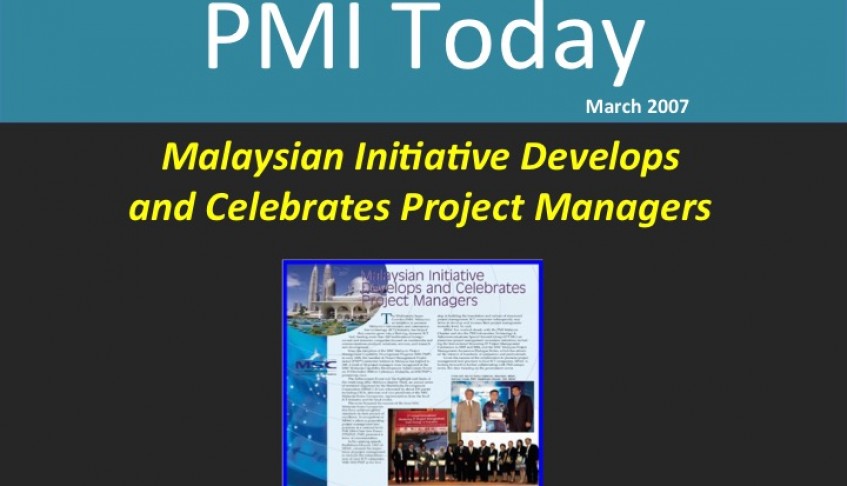
PMI Today (March 2007) : Malaysian Initiative Develops and Celebrates Project Managers
SK Khor Publication Cyberjaya, Malaysia, Management, MSC, PMBOK, PMI, PMP, Project
MSC MALAYSIA PAVES WAY FOR MALAYSIAN PROJECT MANAGERS
15 December 2006, Cyberjaya: Since the inception of the MSC Malaysia Project Management Capability Development Programme in early 2006, the number of certified Project Management Professional (PMP) in Malaysia has tripled to 249 PMPs to date. Total of 30 project managers received recognition at the MSC Malaysia Capability Development Achievement Event on 15 December 2006 in Cyberjaya, Malaysia, for being the pioneer graduating class of the MSC Malaysia Project Management Capability Development Programme (MSCPMP). The Achievement Event was the highlight and finale of the week long MSC Malaysia Quality Week, an annual series of seminars organised by the Multimedia Development Corporation (MDeC).
This Article has been published in PMI Today March 2007 Edition.
MSC MALAYSIA PAVES WAY FOR MALAYSIAN PROJECT MANAGERS
15 December 2006, Cyberjaya: Since the inception of the MSC Malaysia Project Management Capability Development Programme in early 2006, the number of certified Project Management Professional (PMP) in Malaysia has tripled to 249 PMPs to date. Total of 30 project managers received recognition at the MSC Malaysia Capability Development Achievement Event on 15 December 2006 in Cyberjaya, Malaysia, for being the pioneer graduating class of the MSC Malaysia Project Management Capability Development Programme (MSCPMP). The Achievement Event was the highlight and finale of the week long MSC Malaysia Quality Week, an annual series of seminars organised by the Multimedia Development Corporation (MDeC).
Witnessed by about 150 invitees, which includes CEOs, directors and vice presidents of the MSC Malaysia Status Companies, representatives from the local ICT industry and the local media, the MSC Malaysia Capability Development Achievement Event was graced by Tan Sri Abdul Halim Ali, Chairman of MDeC and Badlisham Ghazali, CEO. The event was held to honour the success of the local MSC Malaysia Status companies that have succeeded in achieving global standards in their pursuit of excellence.
In recognition of MDeC’s effort in promoting project management best practices at a national level, Mr. Iain Fraser, PMP®, Chair, Board of Directors PMI®, 2006, took this opportunity to present a letter of commendation during the event. PMI Asia Pacific also took this opportunity to present MDeC with the same recognition letter. MDeC’s effort in advocating project management best practices to MDeC, the PMI Malaysia Chapter and the PMI IT&T Special Interest Group (SIG) has resulted in great achievement with the more than 249 PMPs to date.
In his opening speech, Badlisham Ghazali, CEO of MDeC stressed on the importance of project management to increase the competitiveness of local ICT companies. With MSCPMP as the first step in building the foundation and culture of structured project management, ICT companies subsequently may strive to develop and increase the organizations’ project management maturity level. The MSCPMP programme is a specially designed programme that provides incentives to eligible project managers to obtain the PMP® certification. Badlisham also stated more project managers will be trained in this programme in 2007.
On the same note, Ms Ng Wan Peng, Vice President of MDeC stated that the recognition from PMI® is very encouraging and hopes that PMI® will continuously support MDeC’s project management capability development initiative. MDeC has worked closely with the PMI Malaysia Chapter and also the PMI Information Technology & Telecommunications Special Interest Group (ITT-SIG) Asia Pacific Chapter on numerous project management awareness initiatives, namely the International Mastering IT Project Management Conference in 2005 and 2006 and the MSC Malaysia Project Management Awareness Dialogue Series, which has attracted the interest of hundreds of companies and professionals.
Given the success of the collaboration to push project management best practices to the local ICT companies, MDeC is looking forward to further collaborate with PMI to push the project management best practices, this time focusing on the government sector.
In pursuit of quality excellence, MDeC has also developed other capability development programmes which include the Software Process Improvement (SPI) Programme and Quality Excellence for Software and Technology SMEs (QuESTs) to encourage local ICT companies to adopt the Software Engineering Institute’s Capability Maturity Model Integration (CMMI). To inculcate software testing best practices, Solutions Assessment and Development Centre, the independent testing outfit of MDeC, are looking into similar model for software testing related capability development programmes.
—-
About MSC Malaysia
MSC Malaysia is Malaysia’s most exciting initiative for the global information and communication technology (ICT) industry. Conceptualized in 1996, the MSC Malaysia has since grown into a thriving dynamic ICT hub, hosting more than 1600 multinationals, foreign-owned and home-grown Malaysian companies focused on multimedia and communications products, solutions, services and; research and development. With this unique corridor, Malaysia continues to attract leading ICT companies of the world to locate their industries in the MSC Malaysia and undertake research, develop new products and technologies and export from this base. The MSC Malaysia is also an ideal growth environment for Malaysian ICT SMEs to transform themselves into world-class companies. Furthermore, the MSC Malaysia welcomes countries to use its highly advanced infrastructural facilities as a global test bed for ICT applications and a hub for their regional operations in Asia.
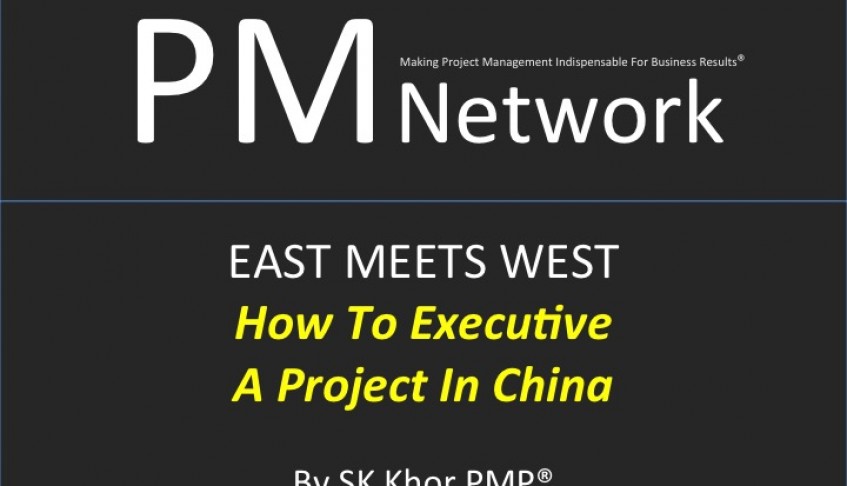
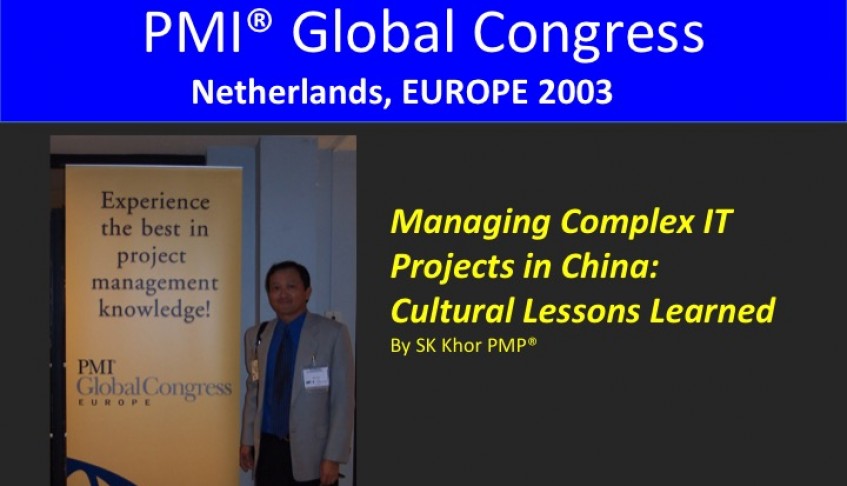
2003 PMI Global Congress Europe: Managing Complex IT Projects in China: The Cultural Lessons Learned
SK Khor Publication Malaysia, Management, PMBOK, PMI, PMP, Project
This paper has been selected and presented by the author on 25 May 2003, PMI Global Congress 2003-Europe, Den Haage, Netherlands. The presentation has been endorsed by the PMI Information Technology and Telecommunications Specific Interest Groups (SIGs) and carried 1.25 Professional Development Units (PDU)
Introduction
The author (SK) has amassed more than 14 years of hands-on experience in managing complex information technology projects. SK’s specializations are in areas of software integration and mission critical system deployment. Among the major projects/systems that have been successfully completed and made operational, with SK’s professional consultancy inputs are:
- Total Airport Management Systems (TAMS) for Kuala Lumpur International Airport, Malaysia
- Integrated Information System for Shanghai Pudong International Airport, China
- Terminal Expansion Program, Beijing Capital International Airport, ChinaSystem Re-integration and Service Optimization for Inchon International Airport Corporation, Korea
- Independent audit on the Operational Readiness Evaluation of Inchon International Airport Corporation, Korea
- System Integration Architecture Development Project for Government of Malaysia and
- New Guangzhou Baiyun International Airport, China
Over the five years managing mega projects in China, SK have gathered priceless experiences and he will endeavour to share with you some of the unforgettable stories, which carry invaluable lessons.
The examples stated are taken from SK’s experiences with actual situations that arose during his work on various airport projects in China.
This paper is a good read for those who are in the midst of, or about to engage on IT projects in China.
Project Background
The traditional airport has been operated in an environment where an airport IT system is disintegrated. Information created by the different departments such as the Baggage Handling System, Security System, Airlines Reservations System or the Departure Control System at the check-in counters are shared or exchanged through conventional means. For example, calling a meeting, telephone, fax or sending a memo, exchanging computer diskettes, etcetera. Obviously such methods are counter productive as it is prone to errors and is not real time. The ultimate consequence of such a standalone system is the airport loses its competitiveness and weakened the bottom line.
Alternatively the International Airport in China adopted the concepts of the Airport Operational Database (AODB) and System Integration of the above mentioned disintegrated IT systems. This integrated system allows the different departments or functional areas within an airport environment to communicate and exchange information seamlessly. The similar concept of an integrated airport system, which is also used at Kuala Lumpur International Airport, had helped to ease the exchange of information among departments improving efficiency, competitiveness and strengthened the bottom line.
Roles played by SK in these International Airports project ranging from Project Manager, Chief Engineer and System Integration Manager of the System Integrator Team which was to oversee the design, implementation and management of the fully integrated IT subsystems to as a Project Advisor to the Airport Authorities.
Section 1 Knowledge Area : Project Communication
Project Management theory advocates project communication to be one of the most important contributor towards the success of a project. More significantly however, during one of my recent project in Korea, project communication is fact identified as being one of the high-risk areas even prior to the commencement of the project.
Thereby, the most challenging tasks faced by a System Integration Manager for any project of this magnitude, is not only the formation and management of the Virtual System Integration project team but also the responsibility of managing this risk.
In this particular instance, taking into consideration the importance placed upon project communication, when a team consists of representatives from over 40 standalone systems, and each project member descended from diverse cultures of more than 15 nationalities, with different beliefs, languages, and levels of social interaction, a breakdown in communication becomes an inevitable problem.
What action was taken in order to mitigate this risk factor?
Interesting Meetings
Establishing Chinese Mandarin as the official language and English as the international language did alleviate the immediate problems of communication but not entirely solving it. Other problems soon arose.
TRANSLATORS
I have established how a Virtual System’s Integration Team for a project like the International Airport in China consists of members from diverse nationalities. This poses acute problems of language and communication. As mentioned, in an attempt to combat this problem we implemented the solution of establishing an official and international language. In addition, we employed respective translators for each engineer. Despite these endeavours, it was discovered although this addressed the immediate problem it created a different set of problems which then called for a different solution.
For example, meetings took longer than scheduled due to the processes of interpretations. I have witnessed countless times where non-Chinese foreign experts have sat in a meeting for 30 minutes with little comprehension of what was being said until the interpreter spoke.
Another problem found is that often during the processes of translation, where critical information may either be lost or distorted, engineers will apply their own understanding of what was translated.
For example, the Chinese Technical specification stated ‘Advance User Interface System’. An engineer translated the term to become ‘Intelligent User Interface System with virtual reality and 3D capabilities or its equivalent.’
In another incident an English Technical Specification stated ‘ The module should consist of Features 1, 2, 3 and 4′. Once translated into Japanese, which in turn was then translated into Chinese became ‘ The sub-system should consist of Features 1, 2, etc capabilities’. It is very obvious information was distorted; module specified by the English Technical Specification became a sub-system with not just 4 features but infinite capabilities!
It became clear that a more innovative and proactive solution was needed. A possible solution directs to the employment of multi-lingual personnel with a resume boasting of a solid working history in a similar role or experience in a multicultural environment. Multi-lingual personnel are found in abundance in countries such as Malaysia.
Run….Run….Fire
Thus far the most immediate issues of national, cultural and language diversity has been attended to. However, there are other less pressing yet no less crucial issues the System’s Integration Manager must address. It has to be done with equal application of diplomacy and efficiency if a united team and consequently a successful project was to be found.
Smoking is a universally acceptable social habit. However, wherever it may be, society is divided into two groups regarding ‘smoking’: those who smoke and those who do not.
It is vital to consider the needs of both non-smoking and smoking members of the team. There are two effective ways in handling this issue.
First, limit the meeting to duration of between thirty to forty five minutes and incorporating frequent recesses to accommodate for the smoker’s crave. Secondly, allocate an unofficial pre-meeting corner for smoking members.
Singling out a non-smoking team member to assist in drawing the non-smoking crowd is a tactful manner to divert the non-smoking from smoking members. I often make the request in this manner.
“Those of you who want to enjoy some fresh air please follow Miss Li.”
We are glad that we didn’t repeat mistakes made by others, such as trying to enforce ‘Smoke Free Environment’ as part of the project rules! We decided against adopting this hard line rule because we believe smoking or non-smoking is a strictly personal lifestyle decision. Our rule of thumb for this kind of issue is ‘each to their own’ if it doesn’t directly impede upon the project’s progression.
However if it does, the matter needs to be handled diplomatically on an individual basis. This situation is similar to another I have encountered in a different project where a team member refused to remove his shoe before entering the computer room.
Section 2 : Knowledge Area : Project Human Resource Management
THE TROUBLE DOOR
Entering without ‘Tot…Tot..may I come in?’
My System Integration Virtual Team consists of members from both local and foreign companies. These members have different respective cultural, social and business ethos, which proved to be potentially disruptive and counter-productive. Even the simple and mundane became issues of contention.
For example, the etiquette of privacy, knocking before entering a room has evolved into a controversial issue.
The local Chinese team member subscribes to the etiquette of knocking on the door before entering the room as do the foreign team members. However the point of conflict arises when one of the local Chinese team member does not realize he is meant to wait for an acknowledgement from within, following foreign etiquette, before entering.
I received complaints regarding this minor etiquette discrepancy from some foreign team members. Their concern was over the issue of confidentiality. I did not think too much of it, informing the foreigners that no harm was intended for it is just the Chinese culture.
What seems to be a storm in a tea cup broke loose one day. A local engineer ‘knocked’ and immediately entered the room. He found himself unwittingly amidst foreign team members reviewing their software product design documents, including source codes on a screen.
“Don’t you Chinese understand the basics of professional behavior?”
The foreign expert rebuked the local engineer. The local engineer thinking himself unjustifiably insulted, left the room.
Soon, news about this unwarranted incident spread quickly among the team members. As a result the whole System Integration Team was divided along cultural alignments: the local experts and foreign experts and communication was strained between the two groups. Unfortunately, the Project Manager was the last person to learn of the internal conflict amongst the team members.
Does this scenario sound familiar to you? How did I resolve this internal conflict? The solution was resolved via the popular Chinese story about the White and Black Cats.
THE SINCERE DOOR
The new project manager is appointed to head a troubled project.
The first immediate task in any troubled project is to restore the TRUST between the customer and contractor. To restore trust, he must show his sincerity. The new project manager had attempted on numerous occasions to engage the customer outside work hours i.e for a drink, a round of golf, etc. However the customer was cautious and had declined his advancement point blank.
He proceeded to place himself strategically where the customer would notice his ‘show’ of sincerity. He purposely chose an office next to the Customer Project Manager’s room. Putting in the long hours, arriving early and leaving late, volunteering for graveyard shifts that no-one else wanted.
Two months later, he got his first private outing.
THE CLOSED DOOR
Software development.
I have learned a very productive strategy while in China: Closed Door Software Development.
Closed Door Software Development typically runs from 1 to 2 weeks. It entails putting the relevant people entrusted in developing the software in a hotel or an apartment. All necessities such as food, drinks and maids to cook and clean are made available hence allowing them to focus on the mission of working around the clock without distractions. The only communication they were allowed to make with the outside world is via the Internet.
The effectiveness of this technique among software developers in your country depends largely on what kind of approach to work and lifestyle they subscribe to. This Closed Door technique might sound good but do remember not to overuse it if you decide to adopt this technique. The critical success factors in implementing this technique are to announce a good reward scheme upfront and emplace Project Managers with proven track records under normal project periods. Otherwise this Closed Door Software Development initiative leaves much to be desired.
Knowing Your Project : Knowing Your People
The role of the Project Manager also encompasses motivating the team. Planning an unexpected holiday for the team to reward their effort in completing certain critical task is one way to maintain team morale and motivation. As are Karaoke sessions, always enthusiastically welcomed among the female members. Likewise a round of golf would be greeted with ecstatic delight from the foreign members of the team. Learning how to play Table Tennis (also called Ping Pong) and Chinese Chess would definitely delight the locals. It is a clear indication that you are striving to blend into the Chinese culture. In return you earn their respect and foster a closer rapport with the locals.
Social drinking is another popular activity in China, as it is anywhere else in the world. I must give warning of the comparatively higher alcohol content in their standard drink than those you can find in my homeland Malaysia.
Caution must be exercised when choosing to begin the night with a Chinese liqueur called ‘Mao Tai’ which contains 55% alcohol. Otherwise, consumed recklessly will find yourself out before second rounds, most embarrassing! According to Chinese culture, it is the highest-ranking official who foots the bill at the end of such an outing. That individual could be you, the ‘Cash Rich’ Project Manager. The term ‘cash rich’ refers to real ‘physical’ cash or notes in hand. In this case, the Chinese RMB are still preferred in majority of places in China rather than electronic transactions or otherwise known as ‘plastic’ which you might have taken for granted elsewhere.
Through such activities the Project Manager has the opportunity to interact with team members in a more relaxed environment hence able to unearth each team member’s strengths, weaknesses and concerns.
My role as the System Integration specialist also entails helping team members to be aware of the significance of their duty in relation to the entire project. For example, helping them understand the hundreds of crucial aviation data messages being transmitted from one end of the airport to the other in order to facilitate a normal routine aircraft landing. Therefore the team members must understand a software glitch, however seemingly minute to them, has the potential of proving disastrous for the entire airport operation. Considering an airport system is a mission critical system, it is of utmost importance team members realise and meet their social obligations and responsibilities
It is also advisable to constantly lead your team in visualizing the end result. In the context of this project, visualizing the first aircraft landing on the runway of the biggest fully integrated airport IT system in China. My job was to show them, inspire them as to how their efforts and contributions towards the team will help realize this dream for modern China. The timely opening of the International Airport in China was vital for China’s admission as a member to the World Trade Organization (WTO). The airport is a showcase of China’s potential and ability to be another world economic super power.
A VCD can destroy your career!!
Take nothing for granted in China. A Director of a company produced a video CD with excerpts from the International Airport in China project together with some references made to his/her personal background. The Director was relieved of his/her duties 12 months later during a tussle for a senior project position promotion. A rival colleague accused him/her of using the Video CD to lend credentials to his/her personal profile.
The moral behind this story is, don’t ever take things for granted in China. Your actions today may hold you at ransom even 12 months later.
Office politics is a common experience for many of us who are in the workforce, regardless in which industry or country. However, a multicultural environment of a mega scale project provides for a completely new and unique experience. The above Director could be said to be a victim of such ‘project politics’.
Be acutely aware and mindful of business cultures and protocols.
During my acquired experiences working in Multinational Companies and on mega projects I have heard of and been subjected to enough office or project politics to ensure I was prepared before embarking upon my appointment in China. My preparation involved investing in books addressing Office Politics in China or direct social interaction with the Chinese themselves or anyone who would be privy to the inner workings of the Chinese people and society. Above all be extra sensitive and try to understand the Chinese society, their way of thinking and its taboo.
Keeping a low profile and reduce the ego can also keep you out of trouble. This is another important insight I have arrived upon after years in project management similar in scale. Alas, such is human nature which makes avoiding office politics impossible with the exception of “a one man project team”, a senior PM Guru wittingly declared.
When dealing in China you should always remember the hierarchy protocol and it’s ‘Quan Xi’ (relationship) driven society. This is because you can’t choose what you like or not like about China. You have to accept, understand and adapt.
Now, when I look back on how SK managed to ‘survive’ the entire project life cycle, I have concluded that :
“To know China, you must begin by knowing the culture.
To know how to manage a project in China,
you must begin by knowing the ‘Quan Xi’.”
For example, a Project Manager for a Multinational Company operated in China often find themselves caught up in the task of striking that fine balance between managing the project driven by contractual obligations and managing the project driven by the ‘Quan Xi’. Currently there are sources you can refer to that may help you equip yourself with knowledge on how to effectively manage ‘Quan Xi’.
How to dismiss the Contractor PM !!!
Across the entire S.I Virtual Team, I have observed the following 5 Project Managers.
PM A:
PM A was one of the major players in the bidding team and was the first PM appointed to head this major project. He had made himself quite popular having established good relations within the organization. Everybody is eager to associate themselves with a mega project as it brings opportunities. Not withstanding, PM A along with his counterpart in the customer organization were both summarily removed by their respective senior management. They have proven to unable to work together.
PM B:
PM B grew up outside of China. PM B possessed all necessary experiences and qualifications in the IT industry and had a background in structured project methodologies. Once appointed to the position of Project Manager, PM B discovered his company had over committed themselves in the project, consequently was under-resourced and encumbered by bad contracts.
He engaged the legal department in an effort to investigate and assess the liabilities the company was to incur if it ever decided to terminate the contract or suspend the project. It followed that the legal department have to report back to senior management about the task PM B has entrusted to them in order for their fees to be covered by the project funds.
PM B’s bosses have sensed the lull before the storm. To save their positions they decided to terminate PM B and as a result end the probing. PM C was thus recruited.
PM C:
PM C came to the project extensively qualified and experienced having been employed for 18 years in China and another 18 years in the USA. His people management skills, business acumen, conflict resolution, crisis management and negotiation skills were all exceptional and highly regarded.
PM C was also valued for his excellent communication skills. Being a superb communicator he employed his communication skills with flair and subtlety. Applying unorthodox means he was able to diffuse explosive project conditions when all else failed, intuitively knowing what needs to be said to whom and when.
It is just fitting that such a shrewd and able person as PM C would recognize a business opportunity when there is ever one to come along. As expected, PM C removed himself from the project in pursuit of his own business during the period of the Internet Boom.
However, SK have to pay high respect to PM C especially how he managed to transform the course of a troubled project in a unconventional ways.
PM D:
PM D, a senior Manager was appointed to replace PM C. PM D was fully aware of how trouble beleaguered the project had become. He especially took note of the fate which befell his two predecessors, PM A and PM B. Meanwhile, PM D was also in wait to pursue his own “dot com” dream.
Needless to say, PM D followed his immediate predecessor PM C and left the project 3 months later.
I found this situation to be a very complicated and interesting one. The question now became: Was it possible to find a harmonious balance between project, company and the individual? Ideally, there should be some synergy among these three however in reality it maybe near impossible to accomplish.
PM E:
In the face of such a crisis where the project was floundering; short of resources, and without stable management, its future looked to be dubious. Nobody from the PM E’s company, it seems, was willing to associate themselves with such a beleaguered project, its infamous reputation having preceded itself. The first and foremost pressing priority was to complete the project. The PM E’S instruction upon appointment was succinct and short.
“Do whatever necessary.”
Regardless of the fate these 5 individuals have met in the end, within the project Management Community, they still remain my best mentors and most importantly friends.
Conclusion
These are the lessons I have learnt from my exposure as a Project Manager in modern China. Although many of these lessons have come to me too late, I am glad to be able to impart my knowledge and experiences to you, the one who wishes to or will be embarking on future projects in China. Having read this white paper, I hope you have gleaned wisdom from my experiences walking the path before you and therefore avoid the same pitfalls I was unable to elude myself.
References:
- SoonKheng Khor and Lee Nan Phin , 2002, Managing Complex Information Technologies Projects™, www.AsiaICTpm.com
- SoonKheng Khor and Lee Nan Phin , 2002, Foundation For IT Project Management ™, www.AsiaICTpm.com
Download Slide:
PMI_EuropeCongress2003_ChinaCulture_Slide

